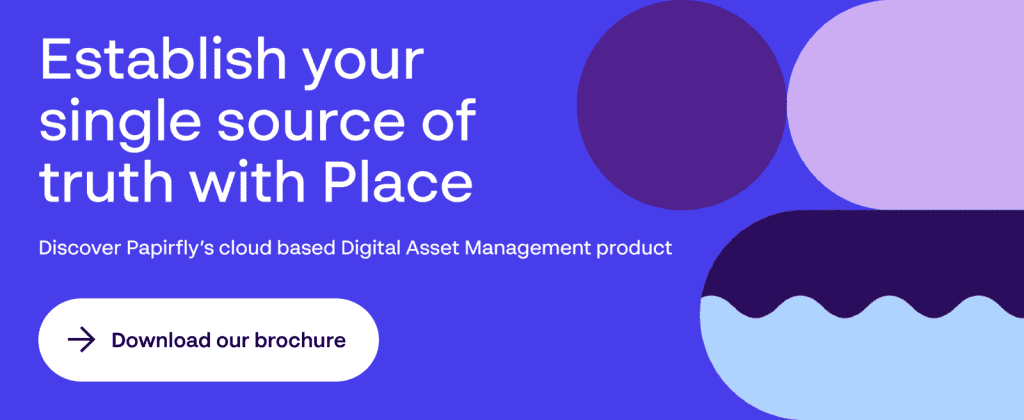For any company, a good Digital Asset Management system (DAM) will save time, effort and resources that would otherwise be wasted. On the other hand, failing to invest in an effective DAM can severely impact your production and service operations and quickly drain your marketing budget.
In this article, we examine how, with the right DAM solution in place, your company can save money and time and create real value, leading to happier, more efficient teams and better customer experiences.
Time thieves in Digital Asset Management
Without a proper DAM system acting as a home for your brand, you can quickly end up with messy and unstructured solutions which lead to time wastage. Here’s a list of typical time thieves branding and marketing teams should watch out for:
1. Searching for digital content
Without a proper system, creative files and marketing materials are easily scattered all over the place. Searching for unaccounted-for assets is time consuming, especially when you also eat into other colleagues’ time. There’s nothing worse than holding up a meeting or deadline looking for assets that should be immediately available.
2. Lost assets
Without a good DAM system, assets are easily lost. Employees spend time looking in vain for assets that cannot be found, often creating unnecessary frustration and friction between teams.
3. Re-creating marketing materials
Without a cloud based system, if a key designer leaves the company, assets might disappear with them. Your teams then need to spend needless time recreating the same assets, rather than focusing on higher value tasks.
4. Circulating outdated brand assets and materials
Customer trust and brand equity depend on consistency, which is undermined if your company cannot present a coherent image. It looks unprofessional and suggests a lack of strategy and integration. There’s no point taking time to craft interesting marketing campaigns and customer experiences if their execution is sloppy.
The hidden costs of Digital Asset Management
Regardless of the industry or the task, there will always be hidden costs. But how significant are these costs for marketing teams? And how do they impact the efficiency of marketing initiatives?
How is the marketing budget spent?
Percolate conducted a study where over 300 enterprise CMO’s, VP’s and Marketing Directors participated.
The study showed that on average, only 48% of the marketing budget is spent on actual advertising. The rest goes on other expenses, which include significant spending on design and brand assets.
An effective ecosystem that efficiently utilises Digital Asset Management can reduce these expenses dramatically. Below are some of the key areas where a DAM solution can save your company money.
Adapting digital content
Adjusting asset sizes and formats, translating copy languages, and adapting marketing materials to fit different channels or platforms, all take attention away from other tasks. DAM software streamlines these activities, so more time can be spent on higher value-adding tasks.
Ineffective systems
Lost files cost money. On average a marketer will look for assets at least 16 times during a work day. In 35% of the cases, without finding them.
These lost assets then need to be recreated, or else tasks must be scrapped – both eating into budgets.
An asset management solution dramatically reduces the likelihood that creative files will be lost, ensuring that marketing efforts are never wasted.
Repeated tasks
The second that marketing materials need to be re-created, costs multiply. The same goes for the time and resources spent on campaigns that need to be withdrawn because wrong or outdated materials were used.As a result, it pays to invest in a DAM solution which ensures that the right assets are available every time they are needed.
Making costs explicit
Let’s flesh this out with an example. Say an employee earns $20 an hour. The employee spends an average of 5 hours a week looking for creative files. This amounts to $100 a week, or $400 a month looking for files. If 5 employees are working this way, this is $2000 down the drain, every month.
Proactive marketers should work with their finance teams to make the case how a DAM solution will reduce time spent searching for assets from hours to minutes and seconds. Hidden costs and wasted efforts are minimised, while workday efficiency increases dramatically. Employees are guaranteed to feel less frustrated, with more time freed up to focus on stimulating, value-adding tasks.

Why Digital Asset Management is important
We have seen how, with an effective Digital Asset Management solution, saving time and money is easy. DAM software gives you complete control of your digital content, and provides user-friendly workflows for effective project management.
Below are some of the other great benefits that a Digital Asset Management has to offer.
Digital asset structure
For those responsible for the brand and associated assets, asset management software will ensure smooth interaction that doesn’t consume more time than necessary. A clear, organisation-wide platform works like a digital library for the brand, ensuring that everybody is looking at and talking about the same information.
Improve company collaboration
An effective DAM solution enables you to share digital assets with ease, minimising long email chains and misdirected communications. Additionally, a cloud based DAM platform provides global, around-the-clock availability for everyone in your organisation.
Predefining file formats and types
Predefining creative file formats and types saves an enormous amount of time. A designer only has to upload one file, while the system will automatically make variations and flexible modifications available.
Designers no longer need worry about inboxes full of requests for small adjustments, as employees are able to tweak digital content to suit their needs. At the same time, clear brand guidelines and rules are built into the DAM platform, ensuring that any modifications remain consistent with the overall brand identity.
Decreased time to market
Properly established, a Digital Asset Management platform dramatically reduces bottlenecks, workflow inefficiencies and communication challenges. Strategies and campaigns can be quickly planned, implemented and learned from, with teams and efforts integrated in a shared hub for the brand.
Digital Asset Management with Papirfly
If you need additional proof to be convinced, there is plenty of data on the potential cost-savings and benefits of DAM. A good DAM-system saves time and costs for any organisation, so long as the investment is planned and considered for the long term.
If you are interested in learning more, check out Papirfly’s cloud based Digital Asset Management product – Place – and how it works within the Papirfly Platform.
